Dental FAQ's
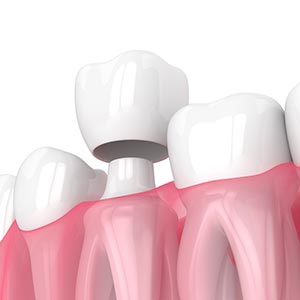
Have you been told that you need a dental crown?
It may be for one or more reasons. Below are some common situations that may warrant tooth protection with a dental crown:
- The tooth has a very large filling that has broken or is ‘leaking’, meaning that the edge of the filling is loose or chipped and bacteria can penetrate below the filling surface into the tooth.
- A root canal procedure has been performed on the tooth. In most cases, a tooth that has been treated by root canal following an infection requires full coverage with a dental crown to prevent the tooth from fracturing.
- The tooth has a large chip by a traumatic injury to the mouth or the tooth cusps have been greatly undermined by tooth decay. After removing any tooth decay and shaping the tooth, the dental crown is used to cover the entire tooth surface above the gum line. This helps prevent tooth fracture due to weakened natural tooth structure.
- When a front tooth becomes dark or discolored due to an old restoration or staining from medications, our dentists may recommend covering the tooth with a natural-looking crown or dental veneer to match your smile.
What is a dental crown?
A dental crown is a tooth restoration that covers the top portion of the tooth (usually the area above the gum line). A crown is manufactured using dental materials that are durable and easy to clean, such as all-ceramic porcelain, zirconia, combined porcelain/metal, or gold. With the exception of gold, crown materials are available in shades to match natural teeth.
A dental crown may be produced in our office using CEREC® CAD/CAM technology, or, it may be sent to a local dental laboratory. Our dentists determine the best option based on the specific design of the crown and the requirements of any adjacent teeth or dental appliances, such as partial denture attachments.
To prepare the tooth for a crown, the dentist will use a drill to remove any tooth decay and shape the tooth surface to support the thickness of material to adequately cover, seal and protect the tooth.
How much does a dental crown cost?
The cost of a crown can vary. Based on the condition of the tooth, support procedures may be necessary to support the crown and protect the health of the existing tooth structure. For example, a ‘core build up’ is needed when there is not enough natural tooth structure above the gum line to stabilize the crown. During up the build up procedure, the dentist will add dental composite materials to create a foundation for the crown.
The tooth may require a root canal procedure if the nerve has become infected, or, the dentist may need to make changes to the gum and bone tissue around the tooth (crown lengthening) to accommodate the crown.
Even with the support procedures that may be needed for the dental crown, a crown is usually less costly than replacing the tooth with a dental implant restoration or bridge.
The best way to obtain an accurate cost estimate for a dental crown is to see one of our dentists for a consultation. During this visit, we will take a dental x-ray and Dr. Gary Bartholomew or Dr. Alex Bartholomew will advise you on the expected procedures and costs.
Schedule Your Consultation Visit with one of our McDonough dentists today – Call 770.507.7435.
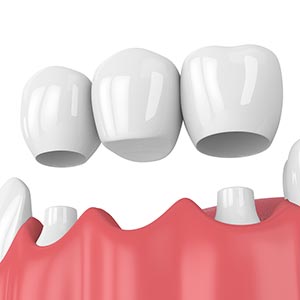
Your dentist may recommend a dental bridge to replace one or more missing teeth. A dental bridge is also called a ‘fixed partial denture’ because unlike removable dental appliances (such as full or partial dentures), a bridge is permanently bonded to adjacent teeth with adhesive materials.
A dental bridge may be made of porcelain ceramics, precious metal (including gold or zirconia) or a combination of porcelain and metal. The type of material selected for a dental bridge is based on location in the mouth and patient preference. For example, a bridge that replaces a missing front tooth is normally made of porcelain ceramic to match the shade of the patient's natural teeth. A bridge that replaces a molar tooth is less visible and may be a combination of metal and ceramics to provide the greatest function and strength.
Dental bridges have been used for many years to replace missing teeth. Our dentists will first carefully examine the location of the missing tooth for replacement with a dental bridge. A bridge should have a stable foundation with a healthy jawbone and the neighboring ‘rest’ teeth should be free of decay. The gums around the bridge must be firm and pink with no signs of bleeding or inflammation (symptoms of periodontal disease).
Why do I need a Dental Bridge?
Ask any dentist or orthodontist - give teeth an open space, and they will move! Dentists recommend replacement of missing teeth to avoid problems related to tooth movement over time.
After a while, teeth that oppose an open space will ‘super-erupt’ away from the jawbone because they no longer have the constant counterforce of the opposing tooth to help maintain their position. Teeth on either side of the vacant spot will ‘drift’ or tip at an angle. This type of tooth movement can make it difficult to chew normally and will eventually lead to further tooth loss.
- Third molars, or wisdom teeth, are the exception to this principle. Located in the far back of the mouth, they present a number of problems because they are difficult to impossible to keep clean. The risk of tooth decay and infection of wisdom teeth is generally high, so dentists advise most patients to have wisdom teeth removed.
Are there any alternatives to a dental bridge?
Dental Implants
In some cases, our dentists may recommend replacing the tooth with a dental implant instead of a bridge. If it is possible to use a dental implant, there are some advantages:
- As a single tooth replacement, a dental implant stands alone. In contrast to a dental bridge, which requires drilling and restoration of neighboring teeth, a dental implant can be restored with a crown to look and feel like a natural tooth without disturbing other teeth. In the case of replacement of a single tooth, our dentists may recommend a dental implant.
- A dental implant ‘integrates’ with the jawbone, which helps to keep the jawbone and blood flow stimulated for healthy cell growth. While a dental bridge provides function and helps maintain tooth position, it does not interact with the bone in the same manner as a dental implant.
Partial Dentures
In cases of multiple missing teeth in different locations in the dental arch (upper or lower teeth), a removable partial denture may be considered. The partial dental appliance can be fitted with ‘false’ tooth replacements for the teeth that are missing.
Partial dentures are generally not an ideal tooth replacement solution. Removable partial dentures do not stimulate blood circulation and bone cell growth, so, over time, jawbone levels are reduced, which may lead to further tooth loss.
How much does a dental bridge cost?
As with any health care procedure, the cost of a dental bridge can vary a great deal. A dental bridge is a recurring investment, it will normally have to be replaced every 5-10 years depending on the location in the mouth and the patient's overall dental health.
If you are struggling with missing teeth, we recommend that you contact our McDonough dental office to schedule a consultation with one of our dentists. Following a dental exam by Dr. Alex Bartholomew or Dr. Gary Bartholomew, we can review your options for tooth replacement and provide you with an accurate cost estimate.
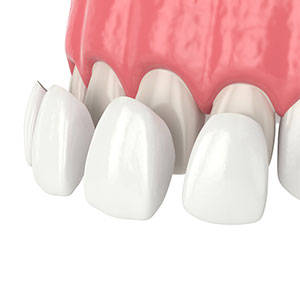
Dental veneers are thin porcelain facings that are adhered to the front of teeth to cover and cosmetically correct defects in the size, shape or color of natural teeth.
Teeth that are cosmetically flawed, but otherwise healthy, can be dramatically improved in appearance with this cosmetic dental procedure.
Cosmetic dental veneers can conceal aesthetic flaws, including:
- Gaps between teeth
- Dark stains on front teeth
- Slightly rotated or crooked teeth
- Teeth that appear small, misshapen, or uneven
- Chipped or worn teeth
Porcelain dental materials beautifully mimic the shade and translucency of natural teeth. Porcelain is also more resistant to staining than other materials, such as composite dental bonding, making it an ideal solution for front teeth.
Placement of cosmetic dental veneers requires minimal preparation of the tooth surfaces. Once adhered to the teeth, dental veneers are very durable, long-lasting and provide strength comparable to tooth enamel.
You will be able to brush and floss your dental veneers with the rest of your teeth as normal. Regular visits for dental cleanings and check-ups will help maintain the beauty of your cosmetic dental veneers for many years to come.
View actual patient photos Before & After Cosmetic Dental Veneers
Cosmetic dental teeth whitening is a popular way to brighten your smile.
Professional whitening products are usually a mixture of whitening ingredients combined with a toothpaste-like gel. The gel helps to keep the whitening formula in contact with the tooth surface and avoid being washed away by saliva.
In-Office & Take-Home Teeth Whitening
Teeth whitening systems are available for in-office treatment for immediate results, or, mouth trays filled with whitening gel may be used at home. Home treatments generally require 2-3 applications to see a significant change.
The Teeth Whitening Process
The main active ingredient in most teeth whitening products is hydrogen peroxide or carbamide peroxide. The peroxide penetrates and lifts away stains caused by smoking, coffee, tea, wine, colas or other dark foods and beverages without changing the tooth enamel.
‘Professional strength’ teeth whitening provided by dentists contains higher amounts of active whitening ingredients than over-the-counter products. Professional teeth whitening products are completely safe when used as prescribed.
The whitening process is simple - whitening gel is applied to the teeth for 20-30 minutes using a custom mouth tray. Many in-office teeth whitening systems will also use a special light to enhance the whitening process.
It is not uncommon for a patient to experience mild tooth sensitivity following teeth whitening. This can usually be relieved with an application of desensitizing gel that is provided by the dentist.
Easy Touch-Ups to Keep Your Smile Looking Its Best
After the initial whitening process, touch-ups are easy! Be sure to store your whitening trays in a safe place at home. Many of our patients purchase a tube of touch-up gel at their hygiene visits to use at home and refresh their smile.
If you have questions about teeth whitening, just give us a call! 770.507.7435
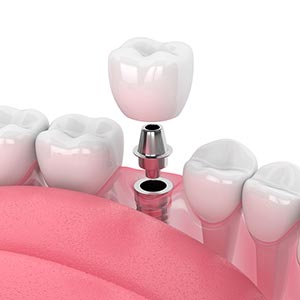
Perhaps the most frequently asked questions we receive about dental implants are related to cost. While this can be difficult to answer without a thorough dental examination, we can offer some information that may be of assistance in your research.
- First, the need for a dental implant occurs when a previously functional tooth is lost due to damage or decay. Your dentist will recommend replacing the tooth to support chewing and to stabilize your bite. In the case of multiple missing teeth or replacing a loose denture, multiple dental implants may be required.
- A dental implant requires a prosthetic restoration to be considered ‘complete’. The dental implant itself is a small, screw-shaped titanium device that is inserted into the jawbone to serve as a foundation for a dental crown or bridge, or, as an attachment for a removal denture or partial denture. Learn more about dental implants.
- Most dental implant treatment plans address other conditions, such as bone grafting procedures, to increase the amount of jawbone and provide a solid support structure for the implant. Or, it may be necessary to perform gum treatments to shape the gums or treat an underlying gum infection that could cause a dental implant to fail.
- Some dental insurance companies partially cover the cost of a dental implant, but it is generally considered a non-covered procedure. Most do, however, cover ancillary procedures, such as the dental crown or bridge, at a percentage, i.e., 50-60% of the insurance carrier's allowance rates, or UCR.
- Dental implants may require support devices and attachments, and in some cases, it may be necessary to perform a ‘guided’ surgical procedure to place the implant in a very specific location.
These are just a few of the considerations that make it critical to schedule a comprehensive dental examination and consultation in order to obtain an accurate estimate of the cost of your dental implant.
During your exam visit, Dr. Gary Bartholomew or Dr. Alex Bartholomew can examine the health of the teeth and gums both visually and with the support of necessary dental x-rays to fully assess jawbone levels and gum health. With the exam information in hand, your dentist can develop a proposed treatment plan to help you understand the expected costs of your dental implant treatment.
Another major advantage of a consultation appointment with one of our dentists is that they will be more than happy to answer any questions you may have or discuss any alternative treatment options with you.
If you would like to schedule a dental implant consultation with one of our McDonough dentists, we invite you to give us a call! 770.507.7435
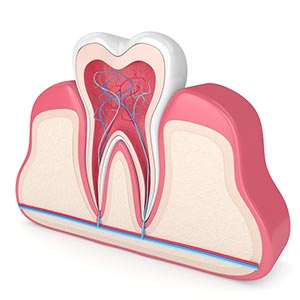
A root canal is an endodontic procedure to remove the pulp and nerve tissue from inside of a tooth. Your dentist may have determined that you need a root canal due to:
- Painful infection within a tooth
- Damaged tissue from an injury, or deep crack in a tooth
- Significant decay that has exposed the pulp of a tooth to bacteria
The primary goal of root canal therapy is to eliminate sensitivity and pain from a tooth that has been compromised by injury or decay. The discomfort you may be experiencing is a sign of inflammation or infection that must be treated by your dentist to prevent a more serious infection, tooth pain, or dental abscess.
Once the pulp and nerve tissue have been removed, the inside of the tooth is carefully cleaned down through the roots. The tooth is then thoroughly disinfected and sealed to prevent re-infection and to preserve the integrity of the tooth structure above and below the gum line.
A tooth that has been treated with a root canal will likely need to be covered with a dental crown to prevent fracture of the top portion of the tooth. The crown will replace lost enamel and strengthen the tooth's surface to withstand biting forces. And, in addition to restoring the tooth's function, an all-ceramic porcelain crown will restore its natural appearance.
Dr. Gary Bartholomew has additional training in endodontic therapies and is able to provide root canal treatment in conjunction with your restorative dental care in the comfort of our McDonough dental office.
Why is it important to save the tooth?
Extracting a painful, infected tooth may seem like a relatively quick and easy solution, however, this approach can lead to more dental problems in the future. Adjacent teeth will slowly shift into the open space left by a missing tooth, affecting your bite. Teeth will not fit together as they should, which can cause weakening or fracture of other teeth, as well as problems of the TMJ (jaw joints).
While it is possible to replace a missing tooth with a dental implant at a later time, this solution will require additional dental visits and be more costly than saving the natural tooth with a root canal and crown, rather than extraction. Saving the tooth with a root canal preserves its place and function in the mouth, and the natural beauty of your smile.
Do root canals hurt?
A root canal procedure is typically performed under local anesthetic and can be as comfortable as getting a filling, or other routine dental procedure. Root canal therapy is a welcome relief to the pain of an infected tooth. Having a root canal is far more comfortable than a severe toothache that can result from avoiding treatment. Following the procedure, any minor discomfort can usually be soothed with over-the-counter pain relievers until all signs of inflammation have subsided.
Don't delay necessary dental treatment.
If a root canal has been recommended to save your tooth, Bartholomew Comprehensive Dental Care can help keep you smiling and pain-free.
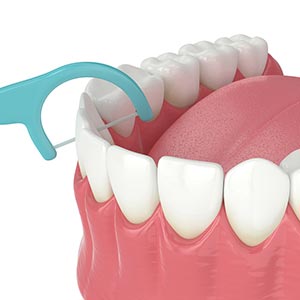
Did you know that there is a ‘right’ way to brush your teeth (and a wrong way)? Don't worry, though, proper brushing is very easy once you know a few tricks.
Brush 2 x Day for 2 Minutes
We recommend that our patients brush their teeth at least twice a day, especially before bedtime. While we sleep, our saliva slows down and does not rinse the teeth as well as it does when we are awake. Having a clean mouth at bedtime helps protect the teeth and gums from harmful bacteria that cause tooth decay and gum disease.
How to Brush Your Teeth
- To get started, choose a soft-bristle toothbrush. Avoid medium or hard brushes, these can be too harsh on the gums, leading to recession and tooth sensitivity. For young children, use a smaller child's toothbrush; it will be easier to handle and maneuver to reach all of the tooth surfaces.
- Use a fluoride toothpaste. Fluoride is a natural mineral that helps strengthen tooth enamel and thus making it more resistant to bacteria strains that cause tooth decay. There are many toothpaste options available; if you use a non-fluoride toothpaste, please ask us about fluoride rinses or other measures you can take to protect your teeth.
- Moisten the toothbrush with a little water and add a dab of toothpaste. Too much fluoride can cause an upset stomach if swallowed. For very young children, use a rice-size dot of toothpaste only as they are more likely to swallow while brushing.
- Holding the toothbrush at an angle (45 degrees) to the teeth and gums, start with the outer and inner surfaces of the teeth and brush starting at the gum line in short strokes away from the gums. Turn the toothbrush and brush the chewing surfaces of back teeth using flat, back/forth strokes. For the back side of the front teeth, turn the toothbrush vertically and brush from the gum line towards to the front of the teeth in short strokes.
- Gently brush your tongue, brushing lightly from back to front. This will help keep your breath fresh by removing old food particles and bacteria.
Don't rush when you brush!
Proper brushing should take at least 2 minutes. Use a timer or a phone app, or, just sing Happy Birthday three times, or the Alphabet song twice, which should take around 2 minutes.
Flossing
We recommend that our patients always floss after brushing. Flossing helps to clean the areas between the teeth where the toothbrush can't reach.
- Start with a section of floss 12-18 inches long so you will have a clean piece of floss for each area. Wrap enough around your finger to control the floss firmly.
- Curve the floss in a ‘C’ and wrap around each tooth as you go between them, clean in an up/down motion. Wrap the used section of floss around your finger as you go, so you always use a fresh section of floss to clean. Be sure to clean behind the back molars.
- After flossing, rinse thoroughly with water to remove any food debris.
Floss Aids & Automated Toothbrushes
There are a number of manual floss aids that can be used to make flossing easier, including special ‘floss threaders’ for cleaning underneath a dental bridge. Be sure to ask our dentists and hygienists for recommendations.
Electronic or battery-operated toothbrushes can be very helpful. They usually do a more thorough job of brushing and make it easier for patients that lack dexterity for a manual toothbrush. Look for a soft brush that is easy for you to handle.
If you have questions or need recommendations for tooth brushing and flossing aids, please do not hesitate to contact Bartholomew Comprehensive Dental Care.
Dental insurance has helped many patients receive necessary dental treatment. It is, however, very different from your automobile, home or medical insurance policy. If you have dental insurance, there are some things you should know about your coverage:
- Dental insurance plans are not a guarantee of payment. They are written with very specific UCR rates (‘usual, customary and reasonable’) for each dental procedure, identified by a standard dental service code. The UCR rate is the highest dollar amount the insurance company will consider for any given procedure. UCRs are different for every dental insurance company and will also vary based on geographic region.
- Each insurance company arrives at their UCR amounts by calculating their membership revenues minus expected payouts based on their business model and statistical analysis of member needs.
- Most dental insurance plans have a maximum benefit allowance that re-sets each year. For example, an annual maximum may be $1,000 - $1,500. The ‘maximum’ amount is the most the insurance company will pay out per year in reimbursement for your dental expenses.
- The annual dental insurance maximum does not mean, however, that $1,000 of treatment equals a $1,000 payment from your insurance company. In addition to UCRs, dental insurance companies set a percentage rate they will pay towards each specific dental code. For example, a comprehensive dental examination, code D0150, might be covered at 100% of the insurance company UCR. A dental crown, however, might only be covered at 50% of the insurance company UCR. And, as you can imagine, because the UCR rates are very different from one insurance company to the next, dental office fees may or may not be less than the insurance company UCR reimbursement cap.
- Most dental plans also have exclusions of coverage, meaning they might not cover dental implants, orthodontics, white fillings (vs. silver), or, they may have a waiting period for a dental crown or replacement of a dental bridge or denture.
Sound confusing? It can be. Before you purchase dental insurance, it is important to research the plan carefully, and then determine if it will actually address your individual dental needs.
We are happy to file dental insurance as a courtesy for our patients in our McDonough dental office. We will prepare a treatment plan with estimated costs, and based on your plan information, provide you with an estimate of your out-of-pocket expense.
The first step to understanding your insurance coverage is becoming informed about your own dental health. Your dentist will perform a comprehensive exam with necessary x-rays to review the condition of your teeth, jawbone levels and gum health, along with recommendations for your care. Equipped with this information, we can then assist you with an estimate.
We have had many patients with dental insurance switch to a health savings plan (HSA) or flex savings account (FSA). These types of health spending plans will typically reimburse the costs of actual treatment vs. a dental insurance UCR table of services that only provides partial reimbursement at best.
We are here to help you maximize your dental insurance coverage! Please do not hesitate to Contact Bartholomew Comprehensive Care if you have questions about dental insurance.